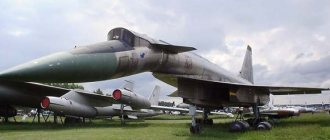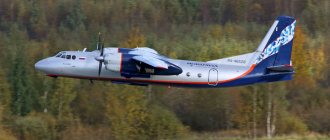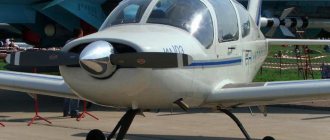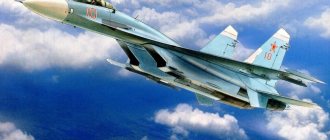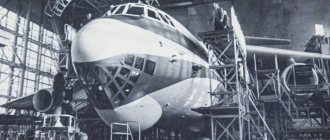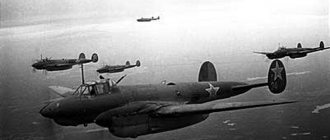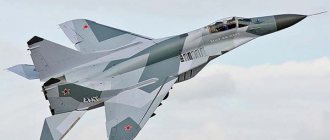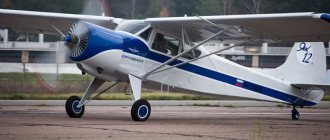One of the most famous seaplanes of the Soviet Union is the A-40 Albatross (aka Be-42). This is a multi-purpose amphibious aircraft created by the Taganrog Aviation Scientific and Technical Complex (TANTK) named after. Beriev and planned as a replacement for the Be-12 seaplane. NATO code designation: "Mermaid".
Structurally, the A-40 aircraft is a high-wing aircraft. The wing sweep is moderate. The tail of the aircraft is T-shaped. In fact, the A-40 is a “flying boat” thanks to the hull design that allows it to remain afloat. Also for operation from land, the A-40 has a landing gear with three struts; For operation from water surfaces, the aircraft has special floats installed under the wing. Thanks to the water rudder installed in the tail of the aircraft, the Albatross has good stability on the water.
Flight performance characteristics of the A-40 Albatross amphibious aircraft:
- Crew: 4-8 people
- Length: 45.70 m
- Wingspan: 42.50 m
- Height: 11.07 m
- Wing area: 200 m²
- Empty weight: 44,000 kg
- Curb weight: 51,000 kg
- Normal take-off weight: 86,000 kg
- Maximum take-off weight: 90,000 kg
- Payload weight: 10,000 kg
- Fuel weight: 35,000 kg
- Engines: main: 2× turbofan engine D-30TKPV
- take-off: 2× turbojet RD-60K
- main: 2× 117.68 kN
- Combat load: 6,500 kg of various weapons:
Aircraft A-40 (Be-42) “Albatross” - brief overview and characteristics
One of the most famous seaplanes of the Soviet Union is the A-40 Albatross (aka Be-42).
This is a multi-purpose amphibious aircraft created by the Taganrog Aviation Scientific and Technical Complex (TANTK) named after. Beriev and planned as a replacement for the Be-12 seaplane. NATO code designation: "Mermaid". Structurally, the A-40 aircraft is a high-wing aircraft. The wing sweep is moderate. The tail of the aircraft is T-shaped. In fact, the A-40 is a “flying boat” thanks to the hull design that allows it to remain afloat. Also for operation from land, the A-40 has a landing gear with three struts; For operation from water surfaces, the aircraft has special floats installed under the wing. Thanks to the water rudder installed in the tail of the aircraft, the Albatross has good stability on the water.
Flight performance characteristics of the A-40 Albatross amphibious aircraft:
- Crew: 4-8 people
- Length: 45.70 m
- Wingspan: 42.50 m
- Height: 11.07 m
- Wing area: 200 m²
- Empty weight: 44,000 kg
- Curb weight: 51,000 kg
- Normal take-off weight: 86,000 kg
- Maximum take-off weight: 90,000 kg
- Payload weight: 10,000 kg
- Fuel weight: 35,000 kg
- Engines: main: 2× turbofan engine D-30TKPV
- take-off: 2× turbojet RD-60K
- main: 2× 117.68 kN
- Combat load: 6,500 kg of various weapons:
The project of the largest seaplane will be resumed in Russia
Yevgeny Pashnin / wikipedia.org
The Russian Ministry of Defense has decided to resume the project to develop the A-40 Albatross amphibious aircraft, which was considered the world's largest aircraft of its class. As Izvestia writes, citing sources in the military department and the aviation industry, as the project is finalized, the aircraft will be modernized. In service, the A-40 is planned to be used as a universal anti-submarine and rescue aircraft.
The A-40 seaplane was developed by the Taganrog Aviation Scientific and Technical Complex named after Beriev under the designation Be-42 in the late 1980s and early 1990s. In 1993, the aircraft project was canceled due to lack of funding and lack of interest from the Russian Ministry of Defense. The plane was 45.7 meters long and had a wingspan of 42.5 meters. The maximum take-off weight of the Albatross was 90 tons. It could reach speeds of up to 800 kilometers per hour and fly over distances of up to five thousand kilometers.
As Izvestia writes, the resumption of development of the A-40 amphibious aircraft is currently at the approval stage. At the same time, the military is forming tactical and technical requirements for the modernized seaplane. If all approval stages are completed successfully, the Russian Ministry of Defense will place an order for the supply of three new A-40s. It is expected that as part of the renewed project, the A-40 will receive submarine detection systems and updated on-board equipment. Other details of the project have not yet been specified.
It should be noted that the Russian Ministry of Defense has already made an attempt to resume the project. In particular, in 2008, the military planned to resume the project to develop the Albatross as a universal transport, rescue and anti-submarine aircraft. In 2012, the military announced the closure of the A-40 project. In 2016, plans were announced to replace all Be-12 anti-submarine aircraft with A-40 seaplanes by 2020.
Today, the world's largest amphibious aircraft is the Chinese AG600, which has been in development since the early 2010s. This aircraft is currently undergoing flight tests. The length of the Chinese amphibious aircraft is 37 meters, and the wingspan is 38.8 meters. The maximum take-off weight of the aircraft is 53.5 tons. The seaplane can fly over a distance of up to five thousand kilometers. The AG600 is capable of carrying up to 50 people and flying at speeds of up to 570 kilometers per hour.
At the end of July 2022, the Chief of the Main Staff of the Russian Navy, Admiral Valentin Selivanov, announced that the Be-12 anti-submarine amphibious aircraft had begun to undergo modernization. As part of the ongoing work, several aircraft have already received new avionics, a sonar system, a magnetic anomaly detector and weapons. The Be-12s are the oldest in Russian naval aviation.
The Be-12 has a length of 30.1 meters and a wingspan of 30.2 meters. The aircraft is capable of flying at speeds of up to 550 kilometers per hour, and its combat radius is 650 kilometers. The Chaika can carry anti-submarine weapons weighing 1.5 tons. Serial production of the Be-12 continued until 1973; A total of 143 aircraft were produced. Today, only 9 Be-12s are included in the naval aviation of the Russian Navy.
A-40 / Multi-role amphibious aircraft
- Total information
- Monitoring
- Data change date: 12/25/2015
Multi-purpose amphibious aircraft A-40 "ALBATROS"
Modifications
. Be-40P - passenger version (project); Be-40PT - cargo-passenger version (project); The Be-42 is a search and rescue variant.
DIMENSIONS.
Wing span 41.62 m; length of the aircraft with the PVD boom is 43.84 m; aircraft height (on land) 11.07 m; wing area 200.0 m2; wing sweep along the leading edge 23.2╟; main cabin (without flight crew cabin): overall length 13.9 m, pressurized length 7.90 m, maximum width 3.25 m, maximum height 2.10 m.
NUMBER OF PLACES.
Crew 8 (A-40) or 3 (Be-40P and Be-40PT); passengers 105 (Be-40P) or 37-70 (Be-40PT); 54 rescued + 4-6 rescuers (Be-42).
ENGINES.
Turbofan engine D-30KPV of the Perm design bureau (2x147.1 kN, 2x15000 kgf).
MASSES AND LOADS
Weights and loads, kg: maximum take-off 86000; maximum when landing: at the airfield 73,000, on the water 85,000; maximum load: commercial 10,000 (Be-40PT), combat 6,500 (A-40), fire version (foam-extinguishing mixture) 30,000; total fuel supply is 35,000.
FLIGHT DATA.
Maximum flight Mach number 0.79; maximum speed of horizontal flight at an altitude of 6000 m - 760 km/h; maximum cruising speed at an altitude of 6000 m - 720 km/h; patrol speed 320-400 km/h; stall speed: with flaps retracted 270 km/h, with flaps extended 182 km/h; service ceiling 9700 m; required length: airfield runway 1800 m, water area 3200 m; take-off run from the airfield is 1000 m; run length at the airfield is 900 m; flight range: with a full fuel supply of 5500 km, with a maximum combat load of 4100 km, with the reception of 15 casualties 5000 km (Be-42), with a maximum payload of 4000 km (Be-40P) or 4200 km (Be-40PT); seaworthiness (wave height) up to 2.2 m; noise level in EPN dB: during takeoff 104, during climb 99, during landing 102.
Design features.
A flying boat with a high swept wing and a T-shaped tail. A boat of large aspect ratio, double raked, with a bottom of variable deadrise. The booster engines are located under the main turbofan engine in the fairings of the main struts of the tricycle landing gear.
EQUIPMENT.
The initial version of the PLO is equipped with a radar with an antenna in the nose cone, an optical sight, hydroacoustic equipment, and a weapons control system. The Be-42 sea rescuer is equipped with radar and navigation equipment that allows rescue operations to be carried out in conditions of limited visibility (for example, in fog, at night). Onboard facilities for selecting those rescued from the water include two six-seater semi-rigid motor boats LPS-6, mechanized ladders, and special equipment. The Be-42 is equipped with equipment for providing medical care. When extinguishing fires, the Albatross is capable of taking water on board without splashdown - in gliding mode, which makes it possible to increase the frequency of flights to the source of the fire. There is an in-flight refueling system with a fuel receiving rod located on top of the nose of the hull
Armament
includes anti-submarine torpedoes, anti-ship missiles (all in the bomb bay), mines, depth charges.
PROGRAM STATUS.
At the stage of flight testing.
ADDITIONAL INFORMATION.
A-40 is the world's largest amphibian. It was developed for long-range anti-submarine operations with the possibility of creating various civilian modifications for widespread use in island and coastal areas that do not have a sufficient number of airfields, as well as in the waters of the World Ocean. Development began in 1983, the first of two experimental amphibians made its first flight in December 1986 (crew commander E. A. Lakhmostov). During testing on the Albatross, 126 world records were set. In early 1992, the Russian armed forces ordered the first 20 anti-submarine aircraft to replace the Be-12 amphibious aircraft and the Il-38 aircraft.
DEVELOPER
JSC TANTK im. G. M. Berieva
Monitoring:
12/05/2017 AEROCAM and ALBATROS - new trends in the unmanned systems market: experience of integrating key industry players
JSC “Engineering”, press release:
In 2022, a landmark event took place in the field of development, creation, operation…
05/30/2016 “Albatross” has flown away: SR-10 will protect Russia from sanctions
Economics today, article:
Defense Blog reports that tests have begun at the Russian Air Force base in Kubinka with...
04/26/2016 The Ministry of Defense will refuse to train pilots on the Czech Albatross
Izvestia, article:
The Aerospace Forces are considering the possibility of redistributing money...
03/03/2016 A-40 anti-submarine seaplanes will replace obsolete Be-12s at the Russian Black Sea Fleet
RIA News":
The newest A-40 Albatross anti-submarine seaplanes will replace Be...
07/23/2012 An economical drone has been created that simulates the flight of an albatross
Gazeta.Ru:
An American scientist has created for the first time an unmanned vehicle that can hover in…
- all materials (292)
Airport .Directory
- Enterprises
- Airports
- Aircraft
- Aviation terms
- Aviation publications
Total entries: 7281 Changes per month: 2
A-40 Albatross - video
The machine is a flying boat with a high wing of moderate sweep and a T-shaped tail. The wing is made of supercritical profiles, its aspect ratio is 9, with a sweep along the leading edge of 23.2°. The use of differential extension and retraction of flaps with automatic rearrangement of the stabilizer made it possible to eliminate the ingress of water onto the wing mechanization devices, reduce the height of the boat and increase its hydrodynamic quality. Floats are installed on short pylons under the ends of the wing to increase the stability of the aircraft on the water. Even during the design process, numerous boat models were tested in the TsAGI hydraulic channel. As a result, on the A-40, operational overloads during takeoff from water were two times less than those of the Be-10 and Be-12. For the first time on this aircraft, from the nose to the redan, a variable deadrise bottom was used. Compared to previous aircraft, it has an unusually low pitch. As a result, the aircraft is characterized by increased seaworthiness and is capable of taking off at a wave height of 2.2 m.
Multipurpose amphibious aircraft Be-200ChS
The Be-200 middle-class multi-purpose amphibious jet aircraft is designed on the basis and using the best characteristics of the famous A-40 Albatross amphibious aircraft. The new generation Be-200 aircraft is the latest achievement of world hydroaviation and the most advanced and efficient amphibious aircraft in existence. Thanks to its perfect aero- and hydrodynamic design, the Be-200's flight performance characteristics are not inferior to analogue land aircraft, but have the unique ability to take off and land on land and water. The Be-200 can be operated from class "B" airfields (runway length - 1800 m) or from inland and offshore waters with a depth of at least 2.6 meters and a wave height of up to 1.2 m (3 points). The plane's crew consists of two pilots. A design feature of the aircraft is the ability to quickly re-equip it to perform various tasks by the crew. The basic modification of the Be-200 amphibious aircraft is a fire-fighting version, it can be filled with water both at the airfield and taken from a reservoir in gliding mode. The Be-200 amphibious aircraft is capable of speeds of 150-190 km/h, in gliding mode, take 12 tons of water into tanks located under the floor of the cargo compartment in 12 seconds. Chemical liquid tanks with a total volume of 1.2 m3 are installed in the cargo cabin of the aircraft. The maximum take-off weight of the aircraft after taking water in gliding mode is 43 tons. The time of salvo release of water over the fire is 0.8-1 sec. at a speed of about 250 km/h. The mass of water discharged for one refueling is up to 270 tons (distance “airfield-fire” - 100 km, “airfield-reservoir” - 10 km). With minor re-equipment, the Be-200 can be used for search and rescue operations, delivery of special teams, transportation of cargo, carrying out sanitary service, patrolling the 200-mile economic zone, monitoring the environmental situation, etc.
Main flight characteristics of the Be-200
Maximum take-off weight from land, t 37.2 Speed, km/h: Maximum 610 Maximum operational 530 Engine type D-346TP Engine thrust, kgf 2x7500 Service ceiling, m 8000 Flight range at H = 8000 m, when refueling 7200 kg, km 1800 Ferry range, km 3850 Take-off run, m: From land 700 From water (at G=37000kg) 1000 Run length, m: To land (at GPOS=37000kg) 950 To water (at GPOS=37000kg) 1300 Crew, persons 2 Length aircraft, m 32.05 Wingspan, m 31.88 Aircraft parked height, m 8.9
The Be-200 amphibious aircraft is a monoplane with a high swept wing, T-shaped tail and a high aspect ratio boat with a variable transverse deadrise. Two sustainer turbofan engines are placed in nacelles on the upper deck of the center section on pylons, above the wing on the landing gear fairings and are protected from water splashes during takeoff and landing by the front part of the wing. The tricycle chassis consists of a front and two main supports. The Be-200 power plant consists of two D-436TP turbojet engines and a TA 12-60 auxiliary power unit. The D-436TP engines were developed by ZMKB Progress and built by the Zaporozhye engine-building enterprise Motor Sich (Ukraine). The engine is a turbojet, three-shaft, high bypass ratio with separate internal and external nozzles. The Be-200 is equipped with a new flight navigation system (FNS) ARIA-200, jointly developed and produced by the Russian-American enterprise ARIA (formerly, now Honeywell (USA) and NIIAO (Russia)). The complex is created on the basis of special microprocessor systems and provides navigation and flight control at all stages in any meteorological conditions, and also automatically analyzes, controls and records the operation of all on-board and additional systems in flight and on the ground. The interior of the aircraft was developed jointly with the British company AIM AVIATION (FLITEFORM).
Basic technical data of the D-436TTP engine
| Takeoff mode | Cruise mode | Maximum cruise | Maximum cruise |
| H=0; M p =0; |
t n =30 o; PH =760 mm Hg.
Dry weight of the engine, 1450 kg Engine service life - before the first overhaul, 6000 hours (4000 cycles) It is possible to install Western-made engines at the request of the Customer.
Passenger version
The passenger version of the Be-200 (Be-210) amphibious aircraft is designed to transport 72 passengers in regions with undeveloped airfield infrastructure. To meet the most varied customer requirements, various aircraft interior options are available: first class, business class and mixed version, as well as an administrative version of the Be-210 amphibious aircraft.
- Crew, people - 2
- Service personnel, people - 2
- Number of passenger seats, people - 72
- Seat pitch, mm - 750
- Flight range with ANZ for 1 flight hour, km - 1850
The transport version of the Be-200 amphibious aircraft allows you to solve the following tasks:
- organizing an effective regional transport network by delivering cargo to hydroports located near central airports;
- transportation of goods to remote islands that do not have airfields, drilling rigs and ships at sea;
- ensuring delivery to hard-to-reach areas.
The cargo version can be easily converted into a cargo-passenger version. Modifications of the Be-200 amphibious transport aircraft:
- cargo version (maximum load - 7500 kg). The aircraft has a pressurized cabin with dimensions of 18.7 ´ 2.5 ´ 1.9 m.
- The cargo-passenger version of the aircraft is capable of delivering up to 3000 kg of cargo and 28 passengers.
Maximum load capacity (cargo + fuel), t -16
Flight range with a commercial load of 7.5t and ANZ for 1 hour of flight, km -1850
Search and rescue option
The Be-200 search and rescue amphibious aircraft is designed for search, visual and electronic surveillance, rescue and evacuation of victims of accidents and natural disasters. The Be-200 is capable of:
- delivery of a rescue team (up to 50 people) and rescue equipment to the disaster area;
- delivery of essential goods to a given area on land or water;
- evacuation of victims (up to 60 people);
- search in a given area of the sea and determine the coordinates of ships in distress;
- classification of targets visually and using electronic equipment.
Sanitary option
The Be-200 allows you to transport 30 victims on stretchers. Take-off weight, t 42. Search and patrol altitude, m 100¸ 8000. Speed range during patrolling, km/h 250¸ 600. Patrol time at a distance of 500 km from the home airfield, hours: up to 5.7. Crew: people - 2 pilots.
- flight mechanic 1
Patrol option
The Be-200 amphibious patrol aircraft is designed to perform the following tasks:
- searching for intruder ships, determining their coordinates in a given area of the sea;
- classification of detected targets visually and using electronic equipment;
- visual determination of the nationality of the offending vessel;
- transmission of data about a detected target to the coast guard control center;
- arrest of the violator;
- directing border patrol vessels to the offending vessel;
- documenting the time and place of border violations and illegal use of fishing gear in the coastal zone.
- Transportation of goods and personnel;
- Participation in rescue operations.
These tasks can be performed by aircraft in all weather conditions, day and night. The maximum patrol time at a distance of 500 km from the home airfield is 5.7 hours. The area of the inspected zone with a detection probability of P = 0.98 at a distance from the base of up to 300 km with a fuel reserve for 1 hour of flight of up to 880,000 km2. Take-off weight, t 42. Search and patrol altitude, m 100¸ 8000. Speed when flying around a disaster zone (fixing an intruder), km/h 220. Crew, persons 3
Modifications
| Model name | Brief characteristics, differences. |
| Be-200 | Firefighting amphibious aircraft, 1 copy built (first flight September 24, 1998). |
| Be-200P | An amphibious patrol aircraft, with equipment for keeping the aircraft in the air for a long time and observation, with an increased crew of up to 9 people, of which 2 are pilots. |
| Be-200PS | Patrol search and rescue amphibious aircraft, further modernization of the Be-200P, designed for search and rescue operations on land and water. Equipped with special search and rescue equipment. The crew consists of 2 pilots, 2 observers, a flight mechanic and 2 rescuers. |
| Be-200ChS (aka Be-200ES-E ) | Multi-purpose amphibious aircraft, mass-produced (first flight August 27, 2002). |
| Be-300 (project) | Multi-role aircraft. Land version of the Be-200. |
Be-200ChS at MAKS 2015.
Winged Firefighter
After the creation of the first models, TANTK continued the development of a civil amphibious aircraft. In 2002, a modified Be-200ChS (Be-200ES-E in the export version) took to the skies for the first time. This aircraft model is maximally adapted to the requirements of the main customer - the Ministry of Emergency Situations - and differs from the basic one in a number of details. The aircraft is equipped with an upgraded on-board flight navigation system ARIA-200M, new EDSU and SPU-200ChS systems, an on-board surveillance system AOS, an external sound warning system SGU-600 and a searchlight SX-5. The cargo compartment is equipped with two places for observers who, through special dome-shaped windows-blisters, can conduct visual monitoring of the area.
The Be-200ES can be used to deliver rescuers, equipment and cargo to disaster areas, evacuate victims, search and locate ships and vessels in distress, identify emergency situations and other purposes.
Photo: Dmitry Terekhov / wikimedia.org
Since 2004, Be-200 aircraft have been involved in rescue operations and firefighting in Russia and around the world. The flying boat has already helped firefighters in France, Portugal, Italy, Greece, Indonesia and Israel, and since June 16 this year, two Russian amphibious aircraft have been on fire watch in Turkey.
In 2010, the Be-200 received a certificate from the European Aviation Safety Agency (EASA). Experts are confident that over the past 20 years the Be-200 has not developed any worthy domestic or foreign competitors. In terms of a number of flight performance characteristics, the Russian amphibian still has no analogues in the world.
Events related to this
Geometry of Pavel Sukhoi's plans
Connecting continents: about Valery Chkalov's flight across the North Pole
"Unique cars"
The same age as the Be-200 is the light multi-purpose aircraft Be-103. The machine has extremely wide functionality. It can be used for passenger and cargo transport, as well as for patrolling coastal areas. The maximum take-off weight of the amphibian is 2330 kg, cruising speed is 180-210 km/h, range is 1070 km.
The Be-103 is equipped with air-cooled IO-360ES4 piston opposed six-cylinder engines from the American Teledyne Continental Motors. In the 2000s, the company counted on selling amphibians in North America. In the end, the US only bought three units. Today, Beriev TANTK is focused on partnership with China.
“Currently, we have signed a contract with the Chinese side for the licensed assembly of 350 aircraft, but we plan to increase this number to 1,000 aircraft. Currently, China operates three Komsomol-assembled aircraft (we are talking about the aircraft plant in Komsomolsk-on-Amur. - RT),” said Yuri Grudinin.
Also, China can become an investor in the projects of the latest middle-class aircraft Be-112 and Be-114. The vehicles have similar tactical and technical characteristics. Both are intended for cargo and passenger transportation, tourist routes and special flights. “The Be-103, Be-112 and Be-114 aircraft are, of course, unique machines. For example, the Be-103 has a modern, original layout; the aircraft has excellent seaworthiness for its class. Its competitiveness in the international market is supported by a well-proven American engine,” emphasized Oleg Panteleev.
In addition, the expert has a positive assessment of the market prospects of the Be-200. According to him, in general, the Beriev TANTK overcame the problems that prevented the launch of serial production of this amphibian, and eliminated most of the shortcomings that were identified by the European Aviation Safety Agency (EASA). “Suffice it to say that the Be-200 is the only amphibious jet aircraft in the world that is mass-produced. This is an indispensable machine for effectively extinguishing fires and carrying out rescue operations. Given the growing number of disasters in the world, the demand for the Be-200 will increase, including in the West,” Panteleev concluded.
Advantages and disadvantages of the A-40 "Albatross"
The main advantage of the A-40 as a seaplane is the convenient location of its wing (high wing), as well as the presence of all the necessary equipment for operation not only from land (three-post landing gear), but also from water (floats and a water rudder). “Childhood” diseases in the design and equipment of the aircraft were actually eliminated during tests in the second half of the 80s.
However, due to almost 20 years of downtime, designers will have to master the production of this complex machine again, study its problems and features, which cannot but affect the rate of aircraft production, especially in the coming years. However, this is not a drawback of the machine, but of political decisions made in the 90s.
A-40 / Multi-role amphibious aircraft
- Total information
- Monitoring
- Data change date: 12/25/2015
Multi-purpose amphibious aircraft A-40 "ALBATROS"
Modifications
. Be-40P - passenger version (project); Be-40PT - cargo-passenger version (project); The Be-42 is a search and rescue variant.
DIMENSIONS.
Wing span 41.62 m; length of the aircraft with the PVD boom is 43.84 m; aircraft height (on land) 11.07 m; wing area 200.0 m2; wing sweep along the leading edge 23.2╟; main cabin (without flight crew cabin): overall length 13.9 m, pressurized length 7.90 m, maximum width 3.25 m, maximum height 2.10 m.
NUMBER OF PLACES.
Crew 8 (A-40) or 3 (Be-40P and Be-40PT); passengers 105 (Be-40P) or 37-70 (Be-40PT); 54 rescued + 4-6 rescuers (Be-42).
ENGINES.
Turbofan engine D-30KPV of the Perm design bureau (2x147.1 kN, 2x15000 kgf).
MASSES AND LOADS
Weights and loads, kg: maximum take-off 86000; maximum when landing: at the airfield 73,000, on the water 85,000; maximum load: commercial 10,000 (Be-40PT), combat 6,500 (A-40), fire version (foam-extinguishing mixture) 30,000; total fuel supply is 35,000.
FLIGHT DATA.
Maximum flight Mach number 0.79; maximum speed of horizontal flight at an altitude of 6000 m - 760 km/h; maximum cruising speed at an altitude of 6000 m - 720 km/h; patrol speed 320-400 km/h; stall speed: with flaps retracted 270 km/h, with flaps extended 182 km/h; service ceiling 9700 m; required length: airfield runway 1800 m, water area 3200 m; take-off run from the airfield is 1000 m; run length at the airfield is 900 m; flight range: with a full fuel supply of 5500 km, with a maximum combat load of 4100 km, with the reception of 15 casualties 5000 km (Be-42), with a maximum payload of 4000 km (Be-40P) or 4200 km (Be-40PT); seaworthiness (wave height) up to 2.2 m; noise level in EPN dB: during takeoff 104, during climb 99, during landing 102.
Design features.
A flying boat with a high swept wing and a T-shaped tail. A boat of large aspect ratio, double raked, with a bottom of variable deadrise. The booster engines are located under the main turbofan engine in the fairings of the main struts of the tricycle landing gear.
EQUIPMENT.
The initial version of the PLO is equipped with a radar with an antenna in the nose cone, an optical sight, hydroacoustic equipment, and a weapons control system. The Be-42 sea rescuer is equipped with radar and navigation equipment that allows rescue operations to be carried out in conditions of limited visibility (for example, in fog, at night). Onboard facilities for selecting those rescued from the water include two six-seater semi-rigid motor boats LPS-6, mechanized ladders, and special equipment. The Be-42 is equipped with equipment for providing medical care. When extinguishing fires, the Albatross is capable of taking water on board without splashdown - in gliding mode, which makes it possible to increase the frequency of flights to the source of the fire. There is an in-flight refueling system with a fuel receiving rod located on top of the nose of the hull
Armament
includes anti-submarine torpedoes, anti-ship missiles (all in the bomb bay), mines, depth charges.
PROGRAM STATUS.
At the stage of flight testing.
ADDITIONAL INFORMATION.
A-40 is the world's largest amphibian. It was developed for long-range anti-submarine operations with the possibility of creating various civilian modifications for widespread use in island and coastal areas that do not have a sufficient number of airfields, as well as in the waters of the World Ocean. Development began in 1983, the first of two experimental amphibians made its first flight in December 1986 (crew commander E. A. Lakhmostov). During testing on the Albatross, 126 world records were set. In early 1992, the Russian armed forces ordered the first 20 anti-submarine aircraft to replace the Be-12 amphibious aircraft and the Il-38 aircraft.
DEVELOPER
JSC TANTK im. G. M. Berieva
Monitoring:
12/05/2017 AEROCAM and ALBATROS - new trends in the unmanned systems market: experience of integrating key industry players
JSC “Engineering”, press release:
In 2022, a landmark event took place in the field of development, creation, operation…
05/30/2016 “Albatross” has flown away: SR-10 will protect Russia from sanctions
Economics today, article:
Defense Blog reports that tests have begun at the Russian Air Force base in Kubinka with...
04/26/2016 The Ministry of Defense will refuse to train pilots on the Czech Albatross
Izvestia, article:
The Aerospace Forces are considering the possibility of redistributing money...
03/03/2016 A-40 anti-submarine seaplanes will replace obsolete Be-12s at the Russian Black Sea Fleet
RIA News":
The newest A-40 Albatross anti-submarine seaplanes will replace Be...
07/23/2012 An economical drone has been created that simulates the flight of an albatross
Gazeta.Ru:
An American scientist has created for the first time an unmanned vehicle that can hover in…
- all materials (292)
Airport .Directory
- Enterprises
- Airports
- Aircraft
- Aviation terms
- Aviation publications
Total entries: 7281 Changes per month: 2
Design
A-40 - a highly seaworthy flying boat is a cantilever twin-engine monoplane with a high swept wing and T-shaped tail. The aircraft's airframe widely uses honeycomb glued structures and non-metallic materials.
- The fuselage
is boat type with one step. The bottom of the boat has a variable deadrise, which made it possible to ensure stability and controllability of the boat when moving through the water, as well as to reduce overloads during takeoff and landing. Technologically, the fuselage consists of three compartments: nose, middle and tail. The nose section is completely sealed and houses the cockpit, avionics compartments, an in-flight refueling rod and some of the aircraft's equipment. In the middle part (sealed) there are fuel system units, a weapons compartment, aircraft control units and wing mechanization units. In the tail section there are fuel system units, aircraft control units, PLO, RTB and electronic warfare systems. The main volume of the forward part of the fuselage is occupied by the crew cabin and includes workplaces for the pilot, navigator and operators of anti-submarine defense systems (ASD), 5-6 people in total, as well as a compartment for rest of the replacement crew, a wardrobe, a living compartment and a toilet. A rudder is installed at the rear of the boat's bottom for steering on the water. - The wing
is of high aspect ratio and low sweep and tapering. The wing consists of a center section, two caissons of the middle part of the wing and two caissons of the cantilever parts of the wing, two tips, as well as mechanization and control surfaces. The wing mechanization consists of retractable double-slotted flaps located along the entire wing span, spoilers, and deflectable slats on the leading edge. At the end parts of the wing, non-retractable floats are installed on short pylons, which serve to increase the stability of the aircraft on the water. - Tail
- consists of horizontal and vertical tails. The tail of the aircraft is T-shaped. The horizontal tail is adjustable in flight and consists of a stabilizer and elevators. The vertical tail consists of a fin and rudder. The rudder is two-section; a trimmer-servo compensator is installed on the lower section. - The landing gear
is a fully retractable tricycle landing gear with nose gear. In flight and during takeoff and landing on water, the front strut is retracted into the fuselage, and the main strut is retracted into fairings located behind the wing. The main landing gear supports have a pyramidal power structure with a strut, which is also a retraction and release cylinder. Each main support has a trolley with four brake wheels and a hydraulic damper. The front support is rotating. The landing gear ensures that the aircraft can independently descend into the water and exit the water onto the shore. - The power plant
is two mid-flight turbojet engines D-30 KVP. To reduce the take-off time and distance when taking off from the water surface, the aircraft is equipped with two RD-60K booster turbojet engines, which are installed under the main power plant engines in the fairings of the main landing gear. The main engines are installed in nacelles that are located above the trailing edge of the wing, so their water intakes are protected from water even in high waves. The engines are started by the auxiliary power unit (APU). The aircraft has a fuel supply of 35,000 liters and an in-flight refueling system. - The control system
is hydromechanical and includes independent pitch, roll and yaw channels. The plane has two identical control posts. The control system includes a digital self-propelled gun, an autonomous yaw damper, a warning system for entering a dangerous flight mode, and other equipment. - Equipment
- the aircraft is equipped with hydroacoustic equipment, radio-electronic and computing means that allow it to solve combat missions independently or in cooperation with surface ships, submarines and AWACS aircraft. In the sea rescue version, the aircraft is equipped with radar and navigation equipment, allowing rescue operations in conditions of limited visibility and at night. - Armament
- The weapons bay housed three anti-submarine torpedoes or six anti-submarine/anti-ship missiles. The maximum combat load weight is 6500 kg.
A-40 Albatross Dimensions. Engine. Weight. Story. Range of flight. Service ceiling
The development of this original and beautiful A-40 Albatross (Be-42) aircraft began in 1983 at TANTK im. G.M. Beriev under the leadership of chief designer A.K. Konstantinov. After the creation of the Be-12 “Chaika” flying boat in 1960, more than two decades passed; a new generation of designers came to the design bureau, who managed to design and bring the machine to takeoff. The vehicle was conceived primarily as an anti-submarine defense aircraft, but during the design process, solutions were incorporated that made it possible to obtain it as a multi-purpose aircraft: for search and rescue operations, passenger and cargo transportation, and in a fire-fighting version.
Options[ | code]
- A-40 (product B-1) is the first experimental anti-submarine and multi-purpose amphibious maritime aircraft. The aircraft was transferred to factory testing in September 1986 without combat systems and weapons.
- A-40 (product B-2) - built in full configuration. The first flight took place at the end of 1989. The aircraft was used during factory and government testing, and then for demonstration purposes at air shows. Subsequently, the aircraft was used as a flying laboratory demonstrator of promising modifications.
- A-40 (Be-42) - serial production of the Taganrog Machine-Building Plant named after. Dimitrova. New workshops were built for aircraft production, and existing ones were reconstructed and re-equipped. In the early 1990s, the plant received design documentation and was ready for serial production of the aircraft, but the decision to produce it was canceled due to a reduction in funding.
- Be-42 "Albatross" (A-40) - proposed production version for export. On the aircraft, the means of using nuclear weapons were excluded, systems prohibited for export were excluded, and the integration of foreign-made systems at the request of the customer was ensured. In June 1991, the aircraft was first presented at the aerospace show in Le Bourget in France.
- A-40D is a transport and landing aircraft. Project. No funding has been allocated.
- A-40PS is a search and rescue aircraft. Project. After the disaster of the nuclear submarine "Komsomolets", when there was no aircraft capable of splashing down at the submarine in distress, it was decided to give the project priority and it was allocated as an independent type A-42.
- A-40P is a firefighting aircraft. Modification of the aircraft for extinguishing forest and other fires occupying large areas. The plane can take on 25 tons of water while gliding. The aircraft could perform the following tasks: extinguishing fires by dropping water, dropping special fire extinguishing equipment, delivering and disembarking a fire brigade, patrolling fire-hazardous areas visually or using thermal imagers. The plane was not built.
- A-40P is a passenger aircraft. Modification of the A-40 aircraft for non-scheduled medium-haul airlines where there is no conventional airfield network. With the help of such aircraft they hoped to deliver to oil and gas platforms on the open sea. The plane was not built.
Multipurpose amphibious aircraft Be-200ChS
The Be-200 middle-class multi-purpose amphibious jet aircraft is designed on the basis and using the best characteristics of the famous A-40 Albatross amphibious aircraft. The new generation Be-200 aircraft is the latest achievement of world hydroaviation and the most advanced and efficient amphibious aircraft in existence. Thanks to its perfect aero- and hydrodynamic design, the Be-200's flight performance characteristics are not inferior to analogue land aircraft, but have the unique ability to take off and land on land and water. The Be-200 can be operated from class "B" airfields (runway length - 1800 m) or from inland and offshore waters with a depth of at least 2.6 meters and a wave height of up to 1.2 m (3 points). The plane's crew consists of two pilots. A design feature of the aircraft is the ability to quickly re-equip it to perform various tasks by the crew. The basic modification of the Be-200 amphibious aircraft is a fire-fighting version, it can be filled with water both at the airfield and taken from a reservoir in gliding mode. The Be-200 amphibious aircraft is capable of speeds of 150-190 km/h, in gliding mode, take 12 tons of water into tanks located under the floor of the cargo compartment in 12 seconds. Chemical liquid tanks with a total volume of 1.2 m3 are installed in the cargo cabin of the aircraft. The maximum take-off weight of the aircraft after taking water in gliding mode is 43 tons. The time of salvo release of water over the fire is 0.8-1 sec. at a speed of about 250 km/h. The mass of water discharged for one refueling is up to 270 tons (distance “airfield-fire” - 100 km, “airfield-reservoir” - 10 km). With minor re-equipment, the Be-200 can be used for search and rescue operations, delivery of special teams, transportation of cargo, carrying out sanitary service, patrolling the 200-mile economic zone, monitoring the environmental situation, etc.
Main flight characteristics of the Be-200
Maximum take-off weight from land, t 37.2 Speed, km/h: Maximum 610 Maximum operational 530 Engine type D-346TP Engine thrust, kgf 2x7500 Service ceiling, m 8000 Flight range at H = 8000 m, when refueling 7200 kg, km 1800 Ferry range, km 3850 Take-off run, m: From land 700 From water (at G=37000kg) 1000 Run length, m: To land (at GPOS=37000kg) 950 To water (at GPOS=37000kg) 1300 Crew, persons 2 Length aircraft, m 32.05 Wingspan, m 31.88 Aircraft parked height, m 8.9
The Be-200 amphibious aircraft is a monoplane with a high swept wing, T-shaped tail and a high aspect ratio boat with a variable transverse deadrise. Two sustainer turbofan engines are placed in nacelles on the upper deck of the center section on pylons, above the wing on the landing gear fairings and are protected from water splashes during takeoff and landing by the front part of the wing. The tricycle chassis consists of a front and two main supports. The Be-200 power plant consists of two D-436TP turbojet engines and a TA 12-60 auxiliary power unit. The D-436TP engines were developed by ZMKB Progress and built by the Zaporozhye engine-building enterprise Motor Sich (Ukraine). The engine is a turbojet, three-shaft, high bypass ratio with separate internal and external nozzles. The Be-200 is equipped with a new flight navigation system (FNS) ARIA-200, jointly developed and produced by the Russian-American enterprise ARIA (formerly, now Honeywell (USA) and NIIAO (Russia)). The complex is created on the basis of special microprocessor systems and provides navigation and flight control at all stages in any meteorological conditions, and also automatically analyzes, controls and records the operation of all on-board and additional systems in flight and on the ground. The interior of the aircraft was developed jointly with the British company AIM AVIATION (FLITEFORM).
Basic technical data of the D-436TTP engine
| Takeoff mode | Cruise mode | Maximum cruise | Maximum cruise |
| H=0; M p =0; |
t n =30 o; PH =760 mm Hg.
Dry weight of the engine, 1450 kg Engine service life - before the first overhaul, 6000 hours (4000 cycles) It is possible to install Western-made engines at the request of the Customer.
Passenger version
The passenger version of the Be-200 (Be-210) amphibious aircraft is designed to transport 72 passengers in regions with undeveloped airfield infrastructure. To meet the most varied customer requirements, various aircraft interior options are available: first class, business class and mixed version, as well as an administrative version of the Be-210 amphibious aircraft.
- Crew, people - 2
- Service personnel, people - 2
- Number of passenger seats, people - 72
- Seat pitch, mm - 750
- Flight range with ANZ for 1 flight hour, km - 1850
The transport version of the Be-200 amphibious aircraft allows you to solve the following tasks:
- organizing an effective regional transport network by delivering cargo to hydroports located near central airports;
- transportation of goods to remote islands that do not have airfields, drilling rigs and ships at sea;
- ensuring delivery to hard-to-reach areas.
The cargo version can be easily converted into a cargo-passenger version. Modifications of the Be-200 amphibious transport aircraft:
- cargo version (maximum load - 7500 kg). The aircraft has a pressurized cabin with dimensions of 18.7 ´ 2.5 ´ 1.9 m.
- The cargo-passenger version of the aircraft is capable of delivering up to 3000 kg of cargo and 28 passengers.
Maximum load capacity (cargo + fuel), t -16
Flight range with a commercial load of 7.5t and ANZ for 1 hour of flight, km -1850
Search and rescue option
The Be-200 search and rescue amphibious aircraft is designed for search, visual and electronic surveillance, rescue and evacuation of victims of accidents and natural disasters. The Be-200 is capable of:
- delivery of a rescue team (up to 50 people) and rescue equipment to the disaster area;
- delivery of essential goods to a given area on land or water;
- evacuation of victims (up to 60 people);
- search in a given area of the sea and determine the coordinates of ships in distress;
- classification of targets visually and using electronic equipment.
Sanitary option
The Be-200 allows you to transport 30 victims on stretchers. Take-off weight, t 42. Search and patrol altitude, m 100¸ 8000. Speed range during patrolling, km/h 250¸ 600. Patrol time at a distance of 500 km from the home airfield, hours: up to 5.7. Crew: people - 2 pilots.
- flight mechanic 1
Patrol option
The Be-200 amphibious patrol aircraft is designed to perform the following tasks:
- searching for intruder ships, determining their coordinates in a given area of the sea;
- classification of detected targets visually and using electronic equipment;
- visual determination of the nationality of the offending vessel;
- transmission of data about a detected target to the coast guard control center;
- arrest of the violator;
- directing border patrol vessels to the offending vessel;
- documenting the time and place of border violations and illegal use of fishing gear in the coastal zone.
- Transportation of goods and personnel;
- Participation in rescue operations.
These tasks can be performed by aircraft in all weather conditions, day and night. The maximum patrol time at a distance of 500 km from the home airfield is 5.7 hours. The area of the inspected zone with a detection probability of P = 0.98 at a distance from the base of up to 300 km with a fuel reserve for 1 hour of flight of up to 880,000 km2. Take-off weight, t 42. Search and patrol altitude, m 100¸ 8000. Speed when flying around a disaster zone (fixing an intruder), km/h 220. Crew, persons 3


